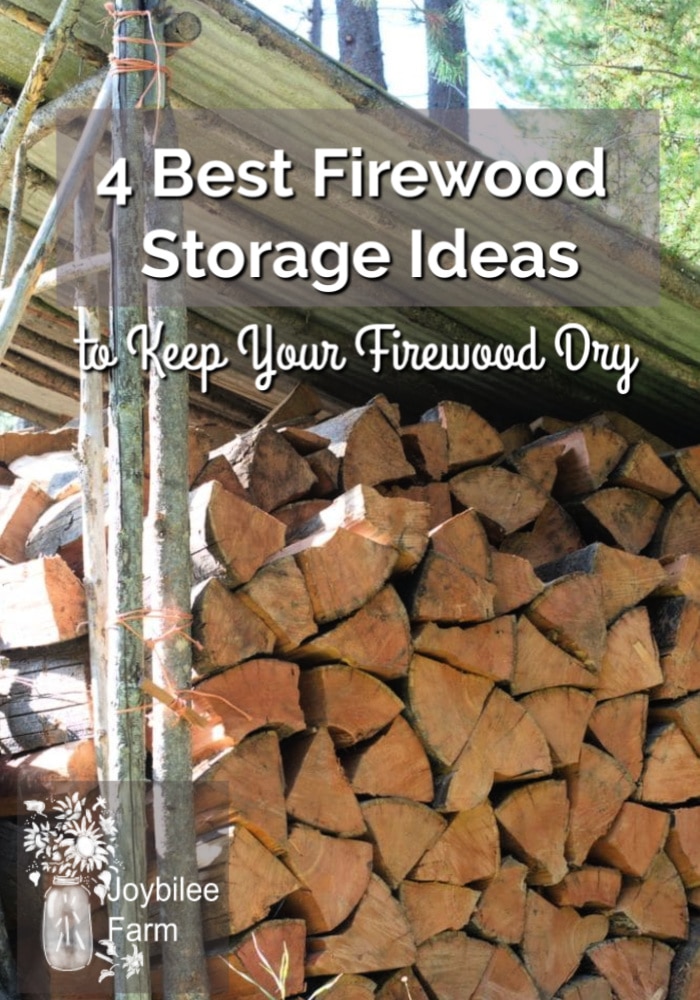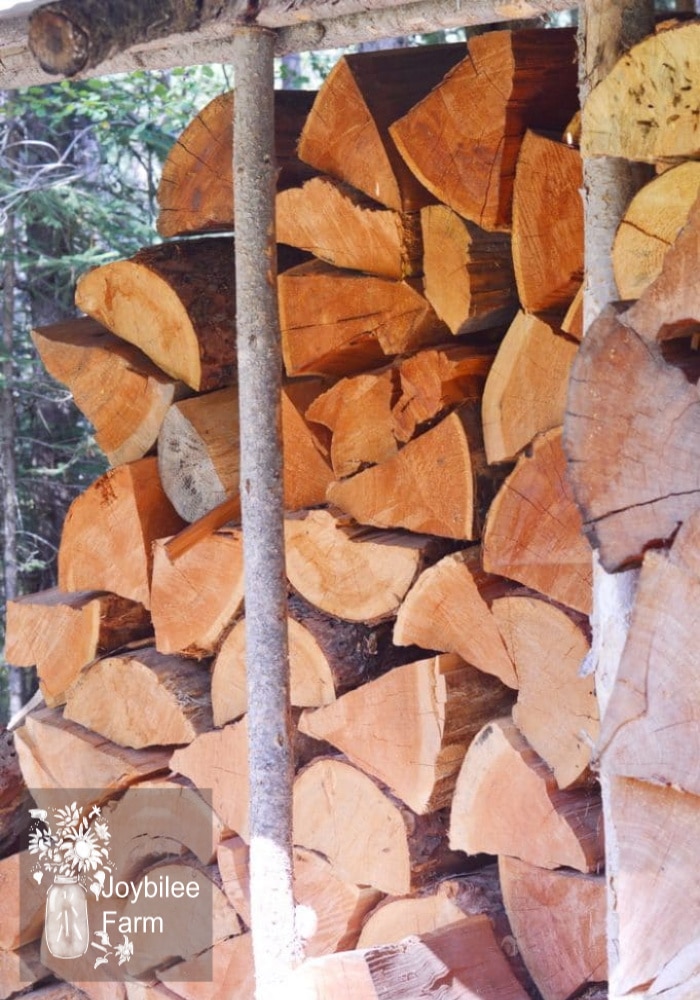Firewood storage can be as much art as science, and these 4 storage ideas will work no matter how big or small your woodpile.
Here at Joybilee Farm wood is our primary fuel for heating and cooking, and we go through quite a bit of firewood each year. On average we’ll use 5 cords of wood with various BTU ratings. This means that we have become masters at cutting and storing wood efficiently.
We’ve learned over the years, that all our hard work chopping and stacking will become a moot point if we allow it to become wet by not giving it protection from the elements, or if we fail to get it dry enough before we need it for heating.
4 key elements of firewood storage
People have many different opinions on what the stack should look like. There are several considerations to take into account when you are deciding where to place your woodpile. Placing it under an evergreen tree may seem logical, but leaving wood in the shade can slow your drying time considerably. You may opt to choose an inside woodshed, but without exposure to sun and wind, the wood may take twice as long to dry.
Wood storage tips
- Use a base to keep the woodpile up off the ground at least 4 inches, so the bottom layer does not absorb water from the ground.
- Expose the pile to sun and wind so that it dries quickly and thoroughly.
- Choose an area with a level piece of ground so the pile won’t topple over.
- Ensure that the wood is at least 30 feet from your home so that the firewood doesn’t become a source of fuel for a wildfire.
- Do not store firewood directly against the outer walls of any of your buildings.

Stacking a cord of wood
A cord of wood is a stacked pile of firewood that measures 8 feet long by 4 feet wide by 4 feet tall, or 128 cubic feet. This is the standard measure of firewood. A freestanding stack of firewood can measure several cords. Generally, firewood is sold by the truck load but the supplier should give you the cost per cord OR tell you how much of a chord is in the truckload. A pickup load of firewood generally measures 1/2 a cord, or sometimes 3/4s of a cord, if the truck has boards to increase the height of the truck bed sides.
Don’t try to bring a full cord home from the woods without strengthening your truck suspension, though. The weight of a full cord of wood can damage your pick up over time.
If you are building a firewood shed from scratch make the building at least 8 feet wide. If it has a slopping roof for snow load, ensure that it can handle at least 4 feet of stacked wood at it’s shortest side. Stacking wood by the cord makes it easy to dry your fire wood and protect it from the elements.
There is no need to purchase 2 x 4s to build your firewood shelter. Waste wood or dead falls can be used to create the supports. A tin roof salvaged from a stock shelter is enough to keep firewood dry.
Since we burn about 5 to 6 cords of wood in the winter, we have 2 firewood shelters measuring 8 feet wide, 8 feet tall and 12 feet long. These shelters will hold 6 cords of wood each and allow us to always have seasoned wood on hand for winter.

The No-Tools Rack
For smaller stacks of wood, this no-tools option may work for you. Supplies are minimal and it all comes together in just a few minutes.
You’ll need:
2 or 3 concrete blocks
2 landscape timbers
2 – 2x4s – 8 feet long, cut in half (so you have 4 4-foot pieces)
To assemble, place the concrete blocks 8 feet apart and use the landscape timbers to lay on top of the blocks. This forms the base of the stack and keeps the split wood off the ground.
Next, take the four 4-foot 2×4’s and insert them upright into each opening in the concrete blocks. This creates the side railing to keep the stack upright.
Get pictures and detailed instructions at this post on Instructables.
The Holzhausen Method of Firewood Storage
My friend Ann at A Farm Girl in the Making uses the Holzhausen method to stack her firewood. This is an old-world method brought to America by European settlers. It’s handy because the round design allows water to run off of the wood, preventing rot while allowing the wood to dry at a much faster rate. Almost two times faster to be exact, according to Ann.
The Holzhausen style is designed to taper, the higher it gets. Once it reaches 6 to 7 feet, a roof can be constructed using additional firewood pieces and bark. The bark protects the wood while allowing it to breathe.
You can get detailed instructions on how to build your own Holzhausen Firewood Storage Stack by going to Ann’s website.
The Firewood Lean-to Shed
This is a fairly common lean-to that you’ll see around most homesteads. It can be used to shelter animals in the pasture or as a protection for your woodpile. In this article from Ana White, you can see that they have used pallets to raise the wood off the ground.
The best part of the lean-to shed is that you still receive airflow around the wood while protecting it from rainfall. This will help the pile dry faster than keeping it in a completely enclosed shed.
Is there a best way to store firewood?
Not really. As long as you follow the rules for keeping the pile dry and giving it airflow, any of these methods will work. Choose the one that fits your level of expertise and fits the space you have available.

BTU of 25 firewood species chart
Explore the BTU ratings of 25 different firewood species with this downloadable chart and get my best tips for Firewood storage and safety by clicking the pink Free download button below.
Other articles in the wood stove series
9 Ways to Use the Ashes From Your Woodstove Around the Homestead
12 Practical Reasons Why Cooking with Wood Makes Sense
Wood Heater or Wood Cookstove: How to Choose
Best Firewood for Your Wood Stove So You Don’t Need to Keep Feeding the Fire
10 Tips for Choosing the Perfect Wood Cook-Stove
Is Wood Heat Eco-Friendly and Sustainable?
How to light a fire in a wood-stove without getting burned
15 Ways to Stay Warm in Winter Without Turning Up the Heat
Best Fire Starter – How to Make Char Cloth
13 Tips to Keep a Wood Cook Stove Functioning at Peak Efficiency




Leave a Reply